Hole in the Clouds
Oct 16, 2009
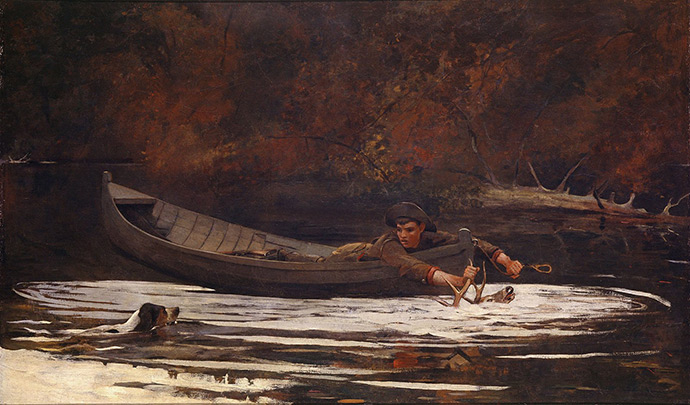
The boy in Winslow Homer's "The Hound and the Hunter" never saw the movie "Bambi," of course, so his relationship to forest and fauna was nothing like that of my generation.. This boy didn't grow up with that single gunshot trumping all other cinematic memories: What just happened? The hunters killed Bambi's mother? His mother?
Homer's boy, unburdened with Disney-fication, just went hunting. That's what you could do this time of year if you were a fortunate American boy. His dog hounded the deer into the water, forcing it to swim rather than run. Deer swim slowly enough that the boy was able to pick it off with the gun that is now in the bottom of the boat. He'll soon have the deer tied up, ready to drag home. Problem is: the dog is now swimming straight for the boat, and if it jumps in, they'll capsize. What should the boy do? What happens next?
Homer was particularly proud of this painting; he felt he got all the details just right--for example, the transition between the boy's pale forearms and suntanned wrists. But even back then in the late 19th century, deer hunting was becoming culturally problematic among a portion of the population; when this painting was first displayed, there were complaints that the deer was still alive, that the boy was trying to drown it. This interpretation is obviously wrong--a desperate deer, thrashing in the water, would swamp the boat, if the boy could hold it at all. No, the deer is not struggling, and the boy's attention has shifted to the dog.
To be continued, sort of.
landscape
dog
fall
hunting
deer
Bambi
animals
Winslow Homer
Walt Disney
Nov 25, 2009

Last winter, up in Ottawa County, Michigan, John Dykstra saw dozens and dozens of wild turkeys--he estimates 50 or 60 on most days--flocking in a field at the back of his woods. He couldn't get close enough to them to take good pictures, so he moved an old metal shed building out there, cut a hole in the wall facing the field frequented by the birds, and sat and waited with his camera. The turkeys came back.
But Dykstra's wild turkeys don't look at all like the wild turkeys I've seen in Alabama and New England, which are much leaner-looking and not so fluffy. These have a thick body type similar to the huge-breasted domesticated birds. When I tried to do a little wild turkey research, however, I learned that there are several varieties, and that the ones I have seen before, even in Vermont and Maine, most closely resemble a variety said to be native to the Rio Grande region of west Texas and New Mexico. Go figure. Apparently, my understanding of all things wild turkey is all full of holes.
They say wild turkeys are making a comeback these days in many parts of the country, including Plymouth, Massachusetts, where they first pricked our cultural consciousness. Ben Franklin thought this bird ought to be recognized as our national animal, and he was onto something.
Drive carefully, y'all.
animals
Thanksgiving
winter
turkeys
(Image credit: John Dykstra)
Feb 13, 2010
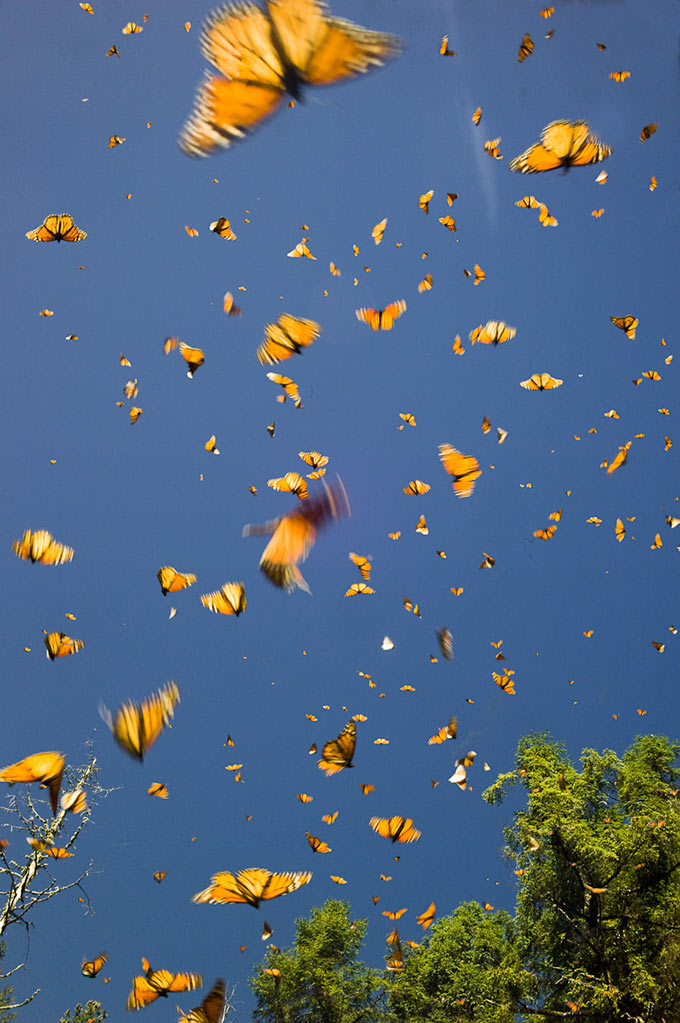
Monarch butterflies know how to enjoy winter; they fly south, leaving the eastern United States and heading for the mountains around Tlalpujahua, in the state of Michoacan, Mexico. Winter nights can get chilly up there in the mountains, and the butterflies huddle together in the trees. But the days are warm and sunny, and every morning as the temperature approaches 70 degrees, the Monarchs take to the air, flocking skyward all at once.
No single Monarch lives long enough to migrate to Mexico in the fall and back to the States in the spring. But somehow, the young butterflies born in Mexico each winter know to start flying north in March, and even know to head for particular ancestral summer homes, which they've never seen before. There, they mate and produce a new generation, which is born not only with the magic power to change from caterpillars into pupae into butterflies but also with the knowledge of when to head south in the fall and how to find the Mexican mountaintop where their ancestors always liked to spend the winter.
animals
butterflies
sky
(Image credit: Woody Campbell)
May 26, 2010

Many kinds of cats sometimes grow big. But Maine Coon Cats commonly grow ridiculously big. And that's all I have to say about that.
animals
Maine Coon Cat
cute
Oct 28, 2010
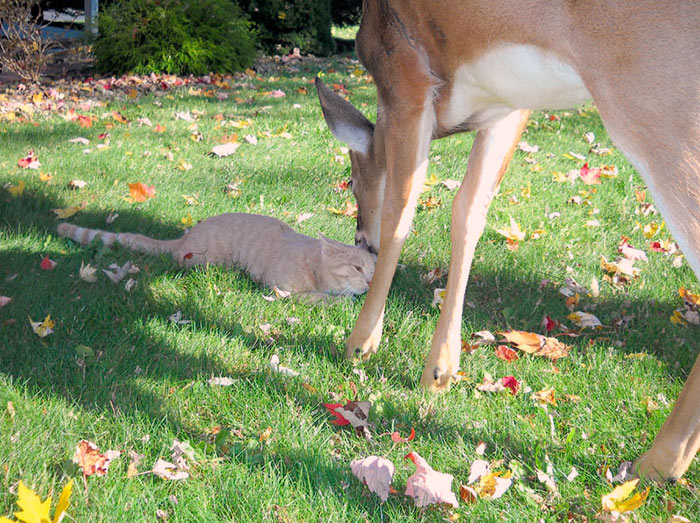

There's an email that's been going around for at least six months or so about this deer that came to somebody's backyard every morning, in Harrisburg, PA, to play with the resident cat. Here are two of the five pictures from the post.
What do you think? Real, or urban legend? Well, after doing my due diligence, I'm inclined to say maybe. Hand-raised deer often behave this way, apparently, and similar goings-on have been described in first-hand reports from several places around the country. For example, from California:
"Every morning our cat used to walk down our lane and disappear into the woods. One morning, I was sick and got up much later than usual to let her out. As I opened the door, I looked down the lane and saw three deer standing there staring at me. To my astonishment, my cat happily bounced down to them, touched noses, and the four of them trotted off into the woods together.
"Perhaps there's a cat/deer accord we are not privvy to?"
deer
animals
cat
cute
urban legend
(h/t: Tina Lackeos)
Nov 16, 2010

Sunday was warm and sunny, maybe the last pleasant day this fall. While the humans sat chatting on their stoops, Toby the dog and Samantha the cat had a little fun with each other.
Samantha is often kept on a leash when out of doors. She doesn't seem to mind the restraint, and whenever Toby stops rassling for a moment to catch his breath, she goes straight at him, begging for a little more nip and snort and tussle. He generally obliges.
dog
fall
animals
cat
Kater Street
Toby
Samantha
Dec 28, 2010

We tossed crumbs out onto the snow in our little backyard, but the birds--with the possible exception of this one fellow--didn't really seem interested.
animals
winter
snow
Philadelphia
backyard
bird
Feb 3, 2011
 Those of us of a certain age take one look at what's going on here and think: things are about to get very bad. We know the scene is set in an isolated spot along the coast of northern California. But actually, the flocking here is on the coast of southwestern England, in Devon, where starlings fill the sky like this all winter long, and it's not a problem at all.
Those of us of a certain age take one look at what's going on here and think: things are about to get very bad. We know the scene is set in an isolated spot along the coast of northern California. But actually, the flocking here is on the coast of southwestern England, in Devon, where starlings fill the sky like this all winter long, and it's not a problem at all.
landscape
animals
England
Devon
starlings
Feb 8, 2011
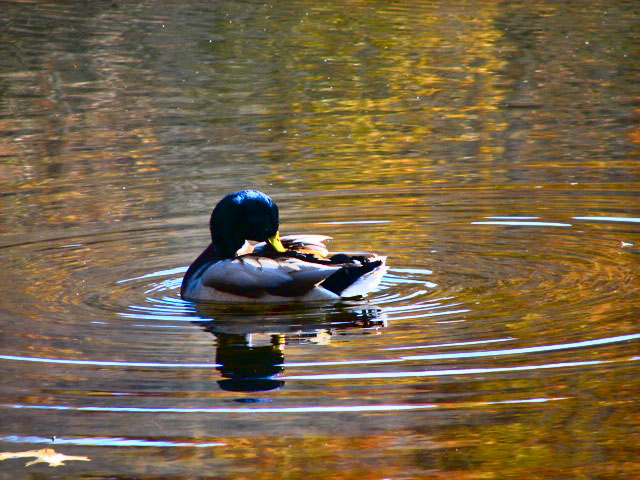
This lucky duck, preening for the camera amongst the ripples of Rockefeller State Park in Pleasantville, New York, was selected for immortality of a sort--or if not immortality, then fifteen minutes of fame, give or take--when Karen and Stuart Berlowitz happened by last fall while out for a walk in the woods. Of all the ducks on all the ponds all over this crazy world, this guy is the one to be get its very own Good Morning post on the intertubes.
New York
fall
animals
ducks
Rockefeller State Park
Pleasantville
(Image credit: Karen Berlowitz)
Mar 31, 2011
 For at least the past fifteen hundred years, Swayambhunath Temple atop a high hill west of Kathmandu–the Monkey Temple–has been a holy site for Buddhists and Hindus both.
For at least the past fifteen hundred years, Swayambhunath Temple atop a high hill west of Kathmandu–the Monkey Temple–has been a holy site for Buddhists and Hindus both.
Hundreds of pilgrims climb the hill every morning before dawn (we're told), up a flight of more than three hundred steps to reach a temple plaza guarded by wooden lions. As the sun rises, the faithful start circling the huge white-domed stupa with its golden spire, spinning prayer wheels as they greet the dawn beneath Buddha's all-seeing painted eyes. Tibetan Buddhists circle the stupa clockwise; Nepali Buddhists go counter-clockwise. There are lots of both.
In addition to the stupa, the Monkey Temple complex features numerous shrines and temples, a monastery, and vendors selling everything from strawberries and tiger balm to postcards and mandalas.
One of the most popular shrines is to a Hindu deity, Heriti, the goddess of smallpox and childhood diseases. Apparently, Heriti is a fertility goddess who developed a niche specialty: keeping children alive till the age of twelve and curing smallpox even in adults. Because divine protection of this sort is much in demand but Buddhism lacked a deity with expertise, Heriti was borrowed from the Hindus. At her shrine, people bring flowers and gifts, both to enlist her aid and to thank her for good work. A donations box has been set up directly in front of her statue.
The whole hill does swarm with monkeys. People who live nearby complain that monkeys venture out into the neighborhood and eat everything green in people's gardens.
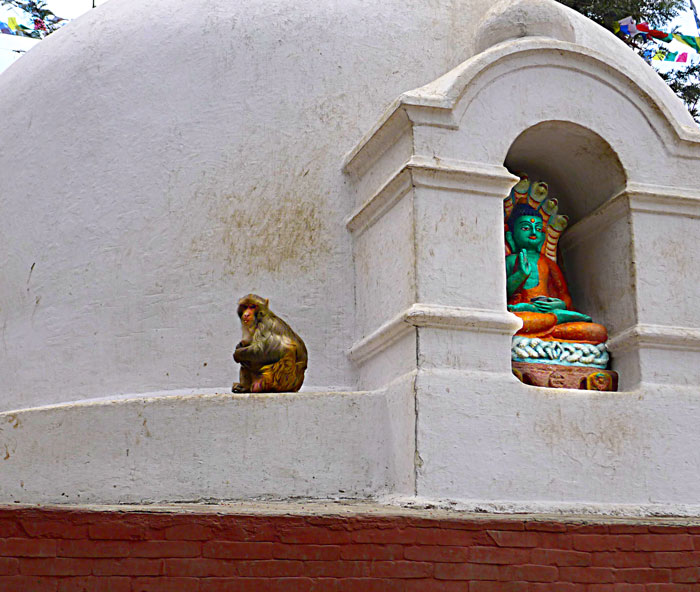


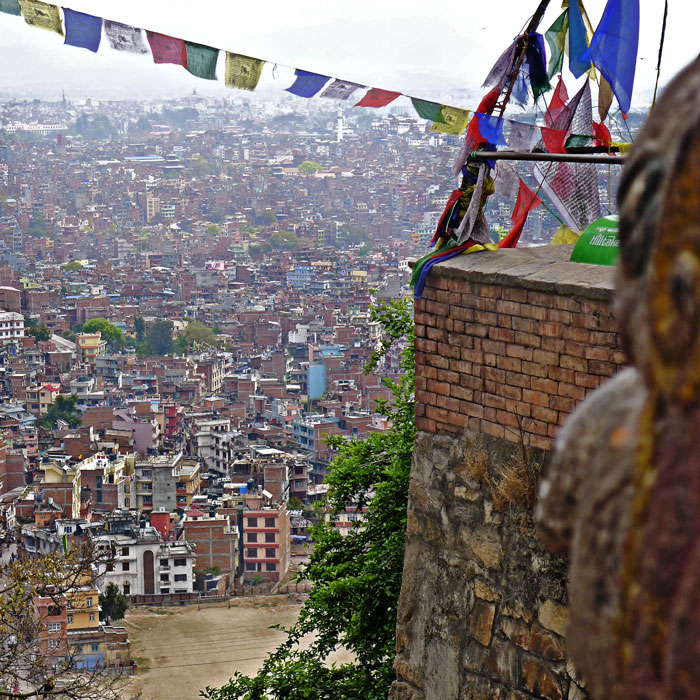
animals
Nepal
Kathmandu
Buddhism
Hinduism
Monkey Temple
religion
Swayambhunath Temple
Apr 1, 2011
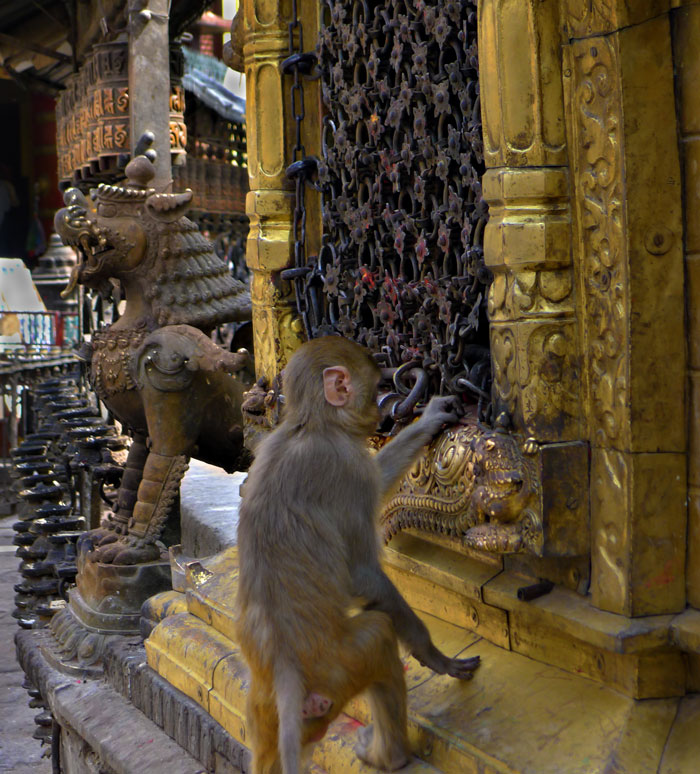
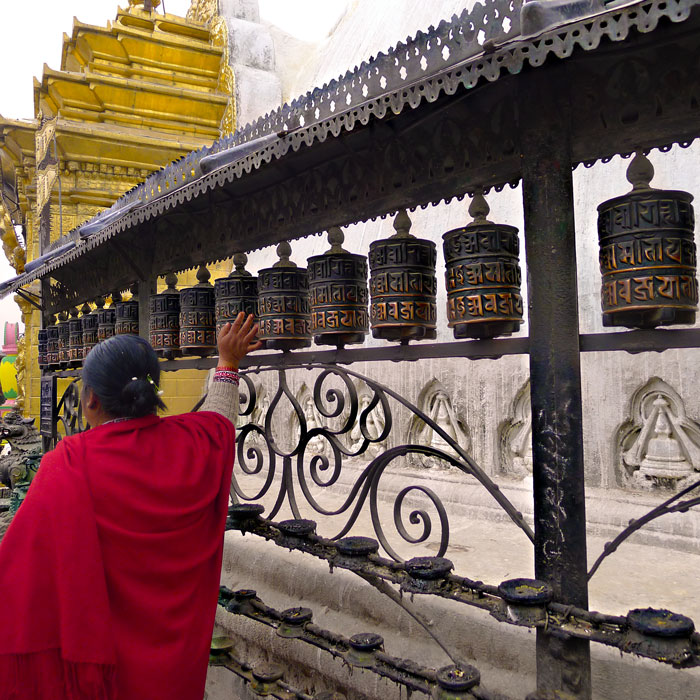


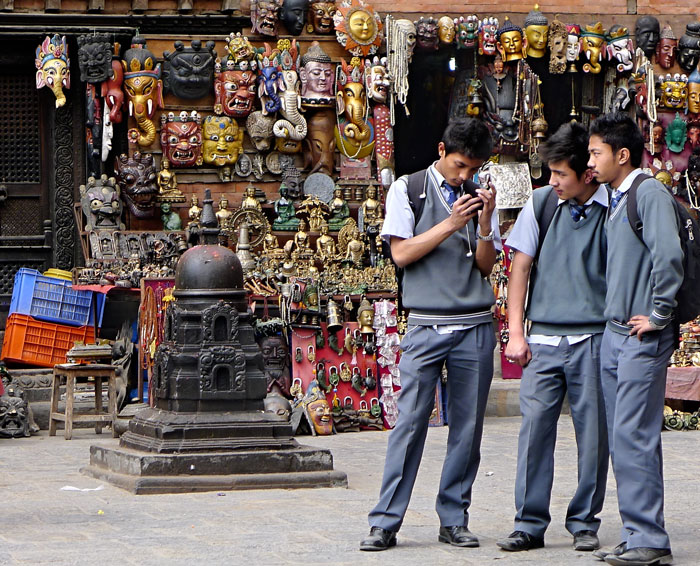


animals
Nepal
Kathmandu
Buddhism
Hinduism
religion
Apr 6, 2011
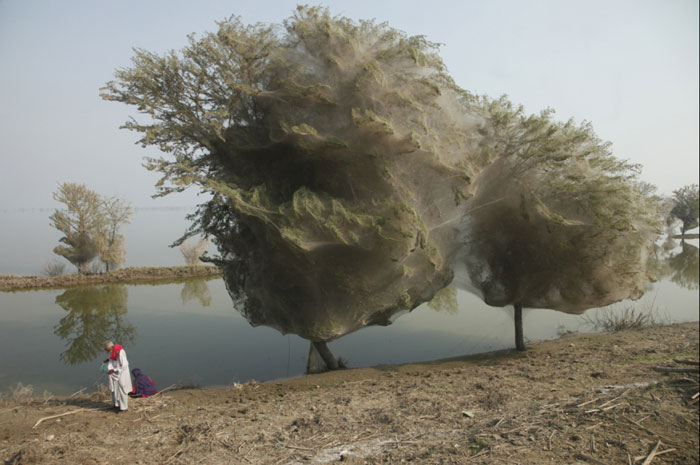 Last summer, when floodwaters swamped one-fifth of all the land in Pakistan, spiders were among the creatures struggling to escape the rising waters. Spiders moved up into the trees, while the water on the ground stayed high for so long that the new eight-legged tree-dwellers had plenty of time to spin web upon web among the branches.
Last summer, when floodwaters swamped one-fifth of all the land in Pakistan, spiders were among the creatures struggling to escape the rising waters. Spiders moved up into the trees, while the water on the ground stayed high for so long that the new eight-legged tree-dwellers had plenty of time to spin web upon web among the branches.
Today, many of the trees of Pakistan are tangled up in spiderwebs. And it has been reported that many of the mosquitoes of Pakistan have been snagged in the webs, resulting in a much smaller than anticipated post-flood mosquito problem.
Pakistan
animals
(h/t: Cathy Goldwater)
flood
spiders
insects
(Image credit: National Geographic)
Apr 10, 2011
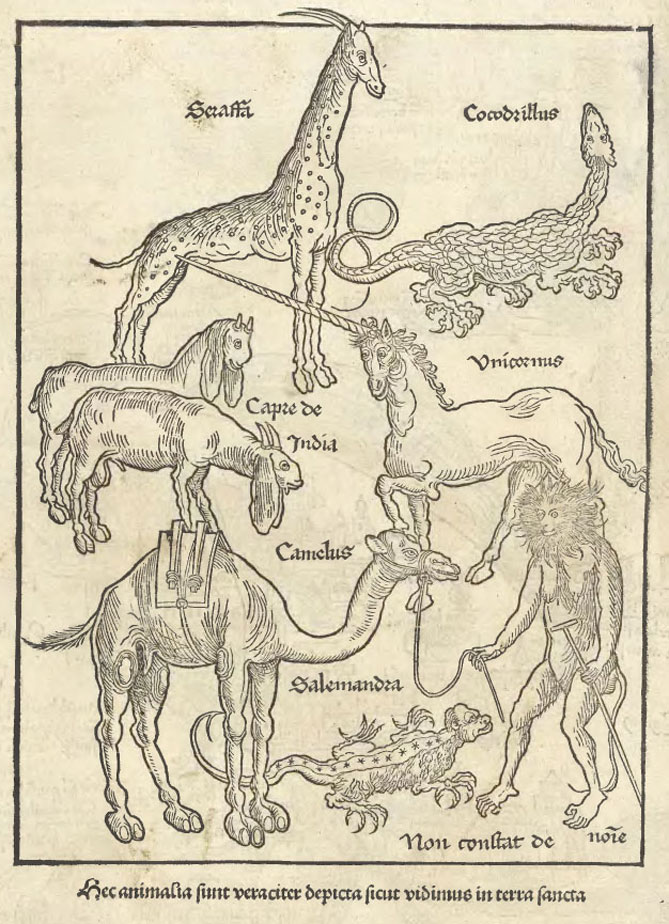 Fifteenth-century pilgrims to the Middle East, upon returning to Europe in 1486, published an account of their journey. "These animals were faithfully painted just as we saw them in the Holy Land," they reported. "Giraffe. Crocodile. Indian goat. Unicorn. Camel. Salamander. The name of this one is not known."
Fifteenth-century pilgrims to the Middle East, upon returning to Europe in 1486, published an account of their journey. "These animals were faithfully painted just as we saw them in the Holy Land," they reported. "Giraffe. Crocodile. Indian goat. Unicorn. Camel. Salamander. The name of this one is not known."
animals
medieval
Mideast
Apr 11, 2011
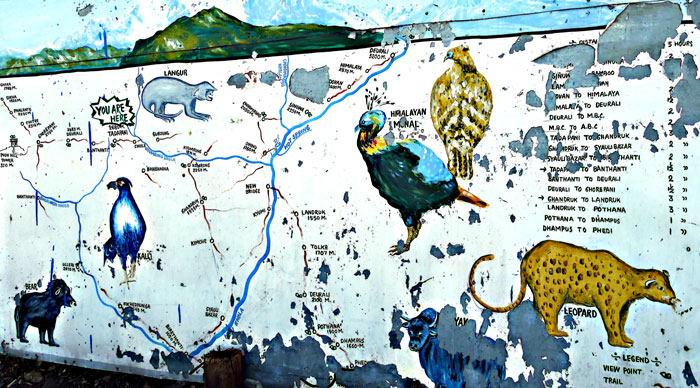 A billboard in a Nepali village along a popular trekking route hints at the animal life to be found in that part of the Himalayas. We saw pheasants and lemurs just as illustrated, but no leopards or sloth bears.
A billboard in a Nepali village along a popular trekking route hints at the animal life to be found in that part of the Himalayas. We saw pheasants and lemurs just as illustrated, but no leopards or sloth bears.
Missing from the billboard but definitely present in the underbrush: mongooses.
animals
Nepal
sign
May 7, 2011
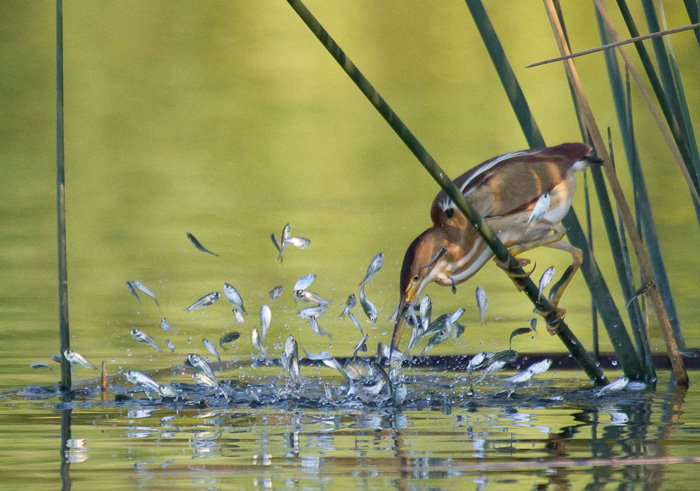 Not all of these menhaden are going to escape from the big bird–but then again, some of them will live to swim another day. Or if not another day, maybe at least till lunchtime?
Not all of these menhaden are going to escape from the big bird–but then again, some of them will live to swim another day. Or if not another day, maybe at least till lunchtime?
The bird is a female least bittern, and she was fishing last week in Horsepen Bayou, near Pasadena, Texas.
Texas
fish
landscape
animals
bird
Horsepen Bayou
wildlife
(Image credit: Gary Seloff)
May 17, 2011
 On Highway 26 the other day, just outside of Dubois, Wyoming, in the Wind River Range, this grizzly and her cub crossed the road and scooted up the snowbank while Hank tried to snap her picture.
On Highway 26 the other day, just outside of Dubois, Wyoming, in the Wind River Range, this grizzly and her cub crossed the road and scooted up the snowbank while Hank tried to snap her picture.
The snow thereabouts was still four feet deep in mid-May, which is why Hank and his friend Pat found themselves scurrying along Highway 26, south of Yellowstone, on their way back east from Montana. All over Yellowstone and the Tetons, late spring avalanches were closing highways, and the boys found their way blocked repeatedly; they backtracked, looped southward, backtracked again, looped further south, and finally broke out onto the plains.
mountains
animals
snow
bear
Wyoming
Wind River Range
(Image credit: Hank Stein)
Jun 24, 2011
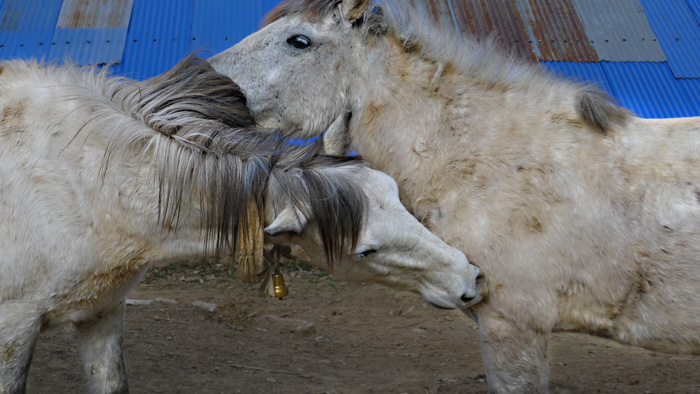 These horses were attending to one another in the schoolyard in the village of Ghorepani. The roof on the schoolhouse, like all the other roofs in Ghorepani, is painted blue. A few kilometers back down the mountain, in the village of Ghandruk, all the roofs are painted white.
These horses were attending to one another in the schoolyard in the village of Ghorepani. The roof on the schoolhouse, like all the other roofs in Ghorepani, is painted blue. A few kilometers back down the mountain, in the village of Ghandruk, all the roofs are painted white.
animals
Nepal
horses
Ghorepani
aw
Sep 13, 2011
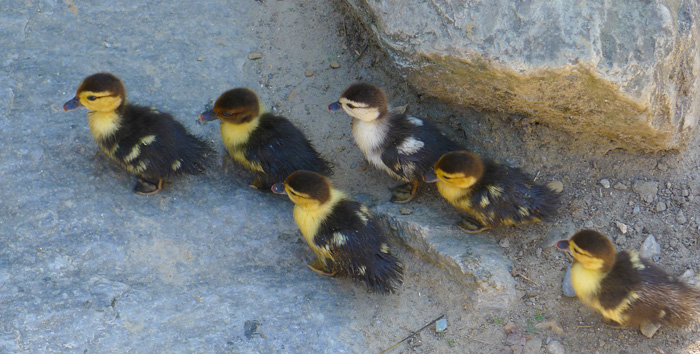 These ducklings are in Nepal, but they don't know that.
These ducklings are in Nepal, but they don't know that.
animals
Nepal
ducks
baby animals
Nayapul
Oct 28, 2011
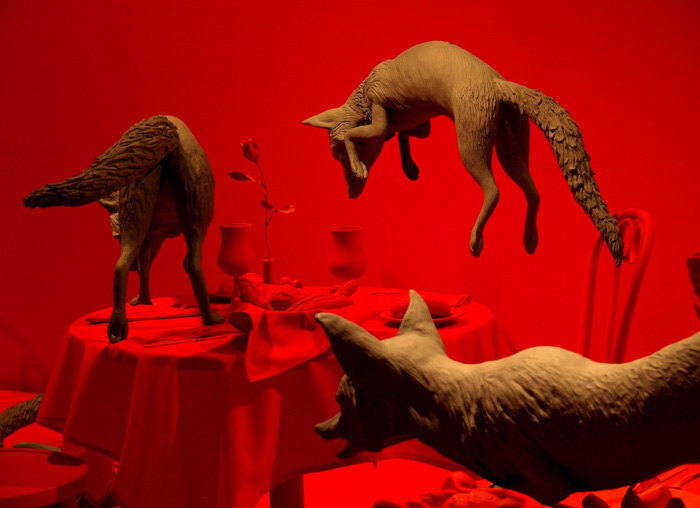 Part of "Fox Games" (1989), a sprawling, life-sized installation at the Denver Art Museum by Sandy Skoglund.
Part of "Fox Games" (1989), a sprawling, life-sized installation at the Denver Art Museum by Sandy Skoglund.
art
animals
Little Red Riding Hood
Sandy Skoglund
red
life-size art installation
foxes
Denver Art Museum
(Image credit: Chris Brown)
Nov 3, 2011
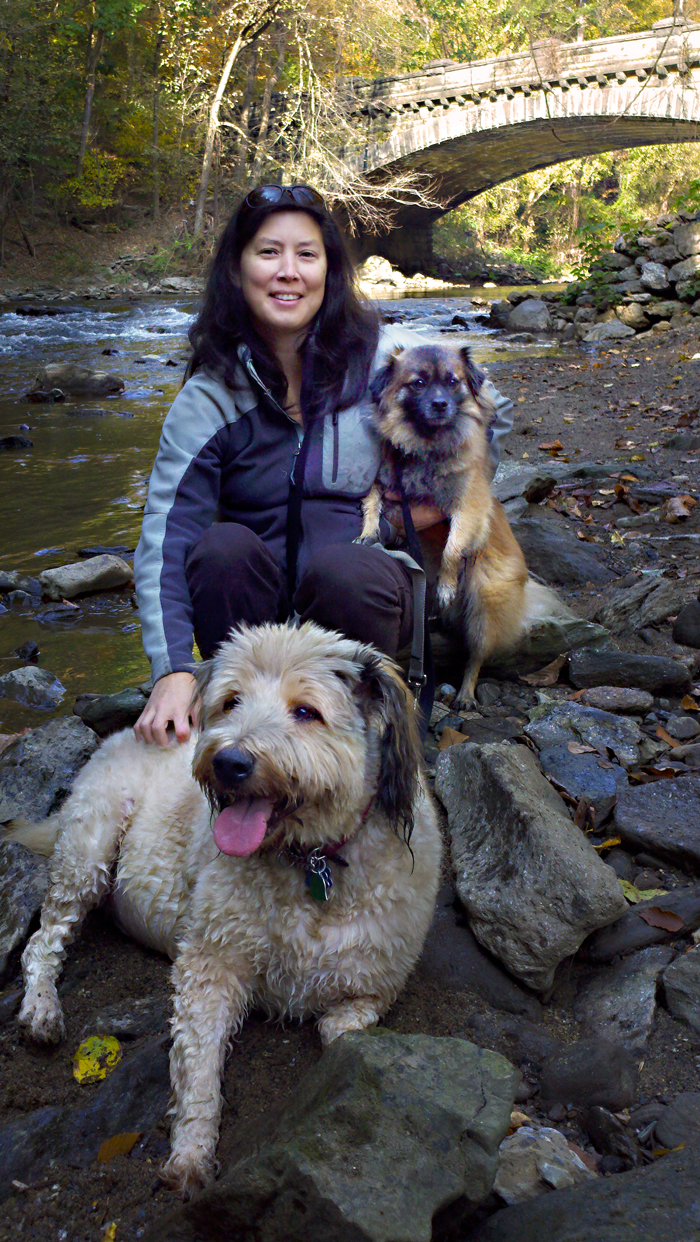 Our neighbor Carolyn Duffy poses for a snapshot along Wissahickon Creek in Philadelphia's Fairmount Park, with her dogs Max and Toby. The big dog, Max, must really like Fairmount Park because he is notorious for making all the decisions with respect to where they'll go on walks and how long they'll stay out. He weighs well over a hundred pounds, and if he doesn't want to go somewhere, it's probably just as well if you don't bother trying to go there.
Our neighbor Carolyn Duffy poses for a snapshot along Wissahickon Creek in Philadelphia's Fairmount Park, with her dogs Max and Toby. The big dog, Max, must really like Fairmount Park because he is notorious for making all the decisions with respect to where they'll go on walks and how long they'll stay out. He weighs well over a hundred pounds, and if he doesn't want to go somewhere, it's probably just as well if you don't bother trying to go there.
landscape
animals
Philadelphia
Carolyn Duffy
dogs
creek
park
Fairmount Park
(Image credit: Sheila)
Mar 20, 2012
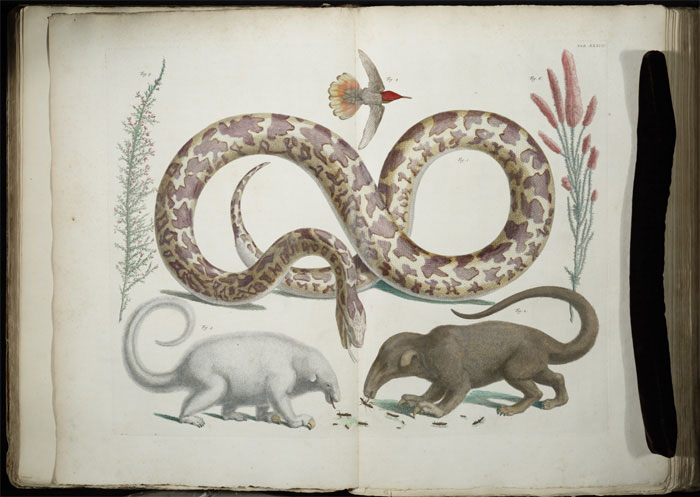 In hopes of fostering the development of medical science in Russia, Peter the Great scoured the West for natural history objects: taxidermy, live birds and insects, botanical and anatomical illustrations, and paraphernalia associated with monsters. Albertus Seba, a wealthy Dutch pharmacist and traveler, had amassed the largest natural history collection of the mid-18th century. Peter bought all of Seba's objects and library, including this book of colored zoological plates, and installed everything in St. Petersburg, where it became the nucleus of the Russian national collections.
In hopes of fostering the development of medical science in Russia, Peter the Great scoured the West for natural history objects: taxidermy, live birds and insects, botanical and anatomical illustrations, and paraphernalia associated with monsters. Albertus Seba, a wealthy Dutch pharmacist and traveler, had amassed the largest natural history collection of the mid-18th century. Peter bought all of Seba's objects and library, including this book of colored zoological plates, and installed everything in St. Petersburg, where it became the nucleus of the Russian national collections.
The book is currently in the Spencer Research Library at the University of Kansas.
Russia
animals
Peter the Great
18th century
natural history
Albertus Seba
(h/t: bibliodyssey2lj)
May 3, 2012
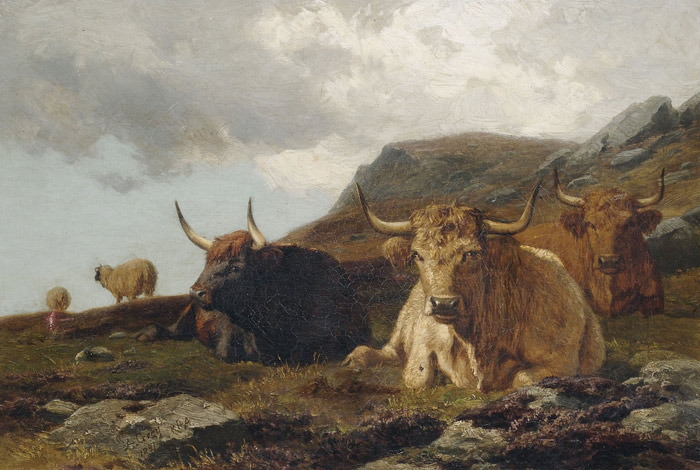 "Highland Cattle," by Scotch-Irish painter Alfred Grey, 1887.
"Highland Cattle," by Scotch-Irish painter Alfred Grey, 1887.
painting
landscape
art
animals
Scotland
Alfred Grey
Ireland
livestock
Jul 18, 2012
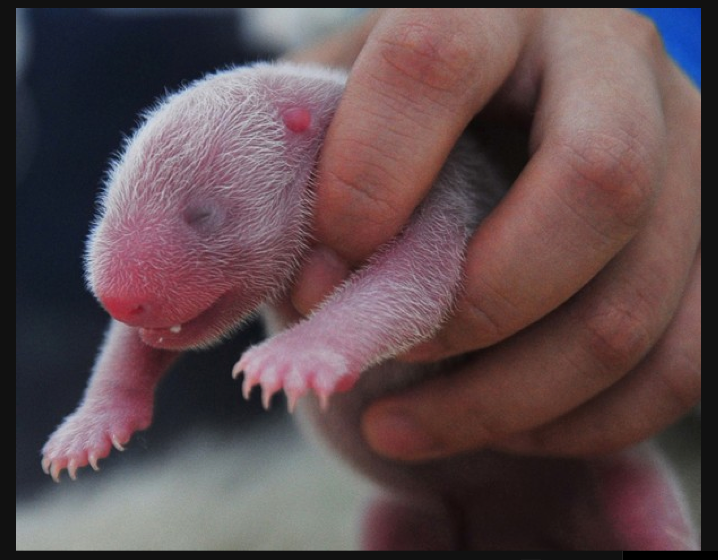 Above, a newborn panda shortly after its birth last week at a breeding center in Chengdu, Sichuan province, China. Below, a few-days-old baby panda in Chengdu works out.
Above, a newborn panda shortly after its birth last week at a breeding center in Chengdu, Sichuan province, China. Below, a few-days-old baby panda in Chengdu works out.
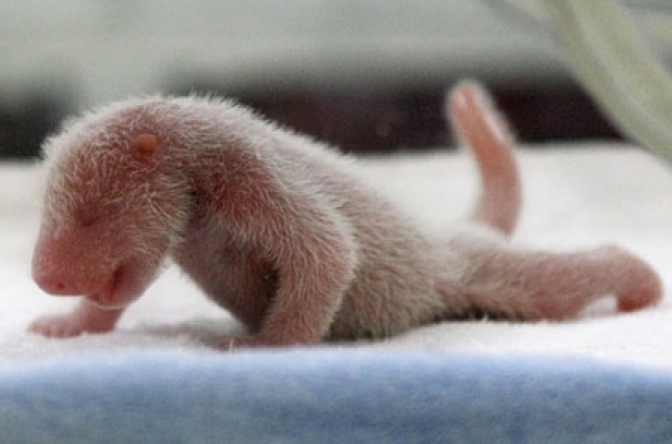
animals
China
panda
babies
Sichuan
Sep 24, 2012


 Maggie Stein and Colin Doody write from Rochester, New York:
Maggie Stein and Colin Doody write from Rochester, New York:
We have two cats: Mac and Jasper. Mac is this tall, slim, elegant, handsome, smart and funny young man. However, as he has a shiny black coat, he is fairly difficult to photograph. You can see his eyeballs in the top picture above. That's one of his favorite hiding places: behind all of his favorite DVDs. He's got a comprehensive collection ranging from boy meets world and full house to sleepless in Seattle to black hawk down.
Jasper is our chubby, off-white, special little boy. While he is super cuddly and floppy (as you can see in the two pictures above), he is also less adept at normal cat functions. He often gets stuck up on top of our shelving unit, and he struggles with bathing, using the litter box, and controlling his caloric intake. He might also have a thyroid problem (which, as it turns out is a huge problem due to Rochester's soil), as he likes to sleep at least 18 hours a day. One of his favorite pasttimes, when he's not sleeping of course, includes pulling Q-tips and sponges out of drawers. He also enjoys occupying public areas in protest. While he doesn't voice his opposition well, we think he may have something against Ikea (see photo below).
We hope that our special boys make the Good Morning email. They would be so proud of themselves. Mac might even link to it on his Facebook account. Those interested might consider friending Macbot J. Catson.... he could use a few more friends. (Please don't tell him we said that.)
New York
animals
pets
cats
Rochester
(Image credits: Maggie Stein)
Oct 1, 2012

John Stein hasn't written us anything from Seattle, Washington, but he does have pictures to share of his dog, Omar Little.
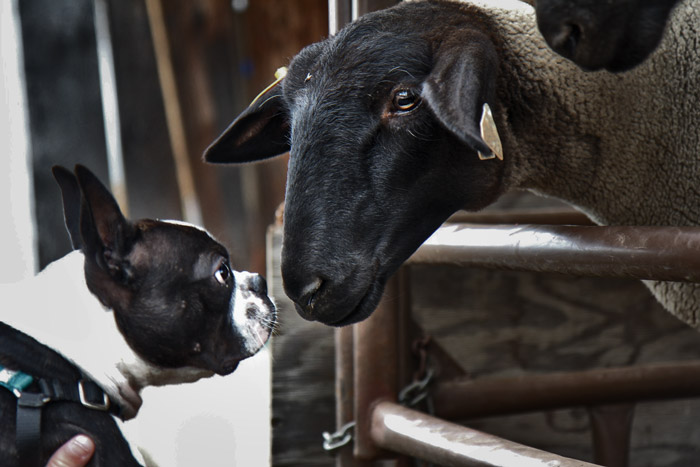
dog
sheep
animals
window
signage
boston terrier
Omar Little
(Image credits: JJ Stein)
Jan 6, 2013
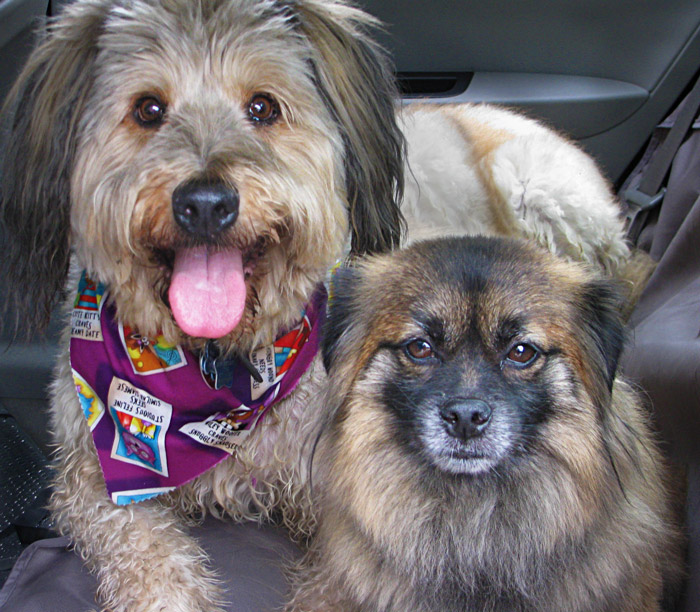 Some of my next-door neighbors on Kater Street.
Some of my next-door neighbors on Kater Street.
animals
Kater Street
dogs
(Image credit: Carolyn Duffy)
Feb 26, 2013
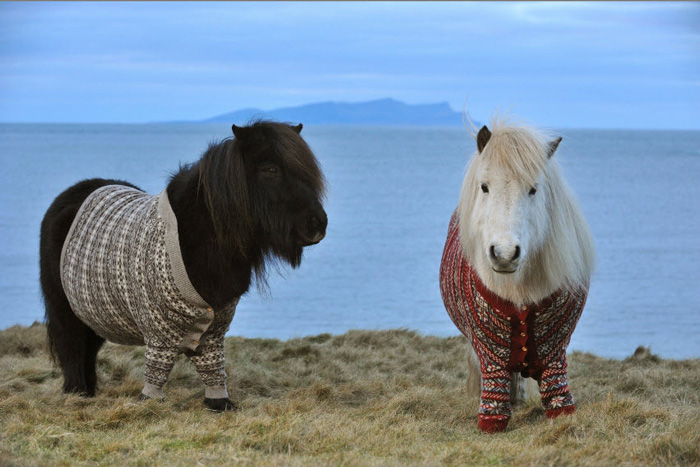 Vitamin, at left in the brown cardigan, and Fivla, at right, wearing red, play starring roles in a new ad campaign urging everyone to visit Scotland in general and the Shetland Islands in particular.
Vitamin, at left in the brown cardigan, and Fivla, at right, wearing red, play starring roles in a new ad campaign urging everyone to visit Scotland in general and the Shetland Islands in particular.
Vitamin and Fivla are classic Shetland ponies, wearing traditionally patterned Fair Isles sweaters custom-knitted by Shetland native Doreen Brown, from yarn spun from the wool of Shetland sheep, and they are posed all warm and cozy on the windswept moor of a scenic Shetland isle, and if this picture doesn't get you to go there then nothing will.
landscape
animals
horses
ocean
Scotland
ponies
sweaters
Shetland Islands
island
(h/t: Larry Schlesinger)
Apr 28, 2013
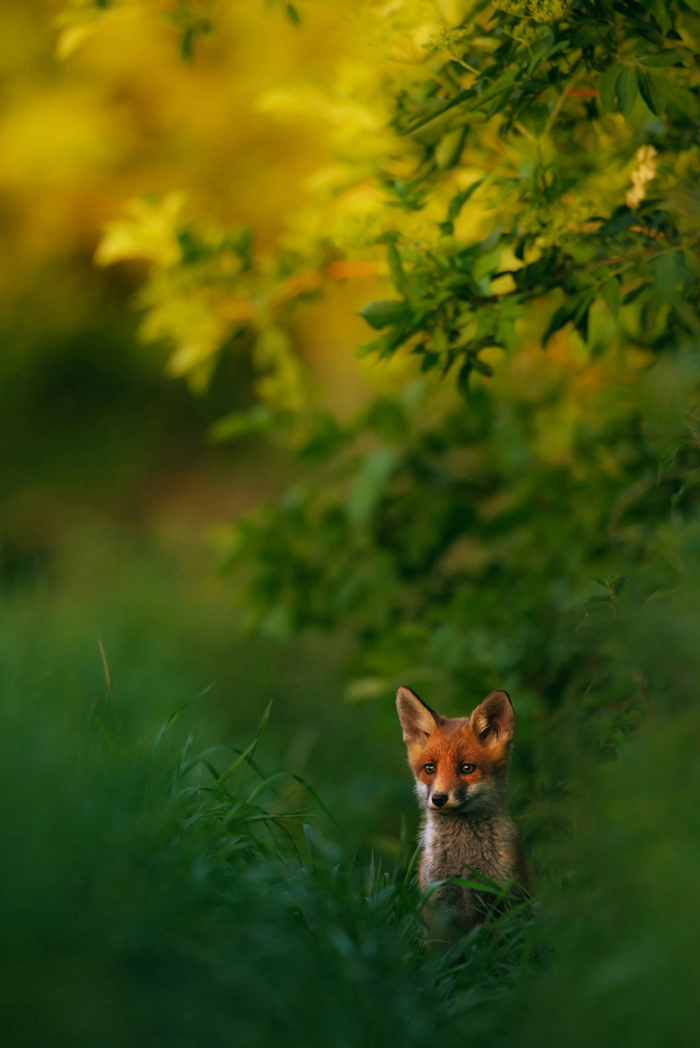 The 2013 photographer of the year for the GDT. a society of German wildlife photographers, is eighteen-year-old Hermann Hirsch, who called his winning shot "Evening Idyll."
The 2013 photographer of the year for the GDT. a society of German wildlife photographers, is eighteen-year-old Hermann Hirsch, who called his winning shot "Evening Idyll."
landscape
Germany
animals
fox
(Image credit: Hermann Hirsch)
Sep 14, 2013
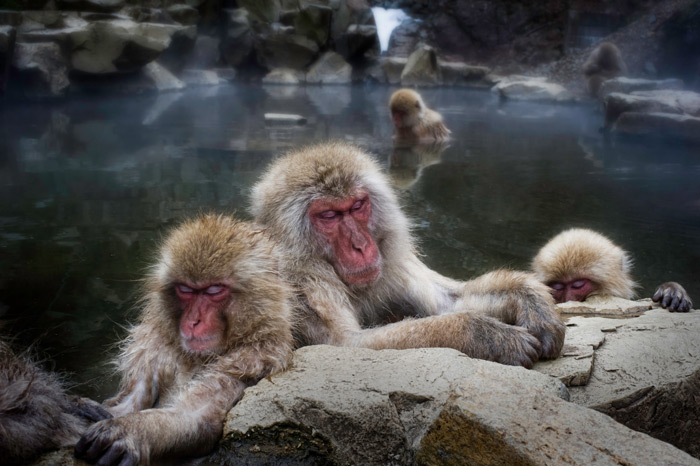 Japanese macaques, native to much of the country, are the world's northernmost species of non-human primates. They can tolerate below-zero temperatures (F) and spend months at a time living in the snow.
Japanese macaques, native to much of the country, are the world's northernmost species of non-human primates. They can tolerate below-zero temperatures (F) and spend months at a time living in the snow.
Some but not all of the snow monkeys congregate in and around hot springs during the wintertime.
animals
Japan
winter
monkeys
hot spring
Hokkaido
(Image credit: Trey Ratcliff via Stuck in Customs)
Nov 19, 2013
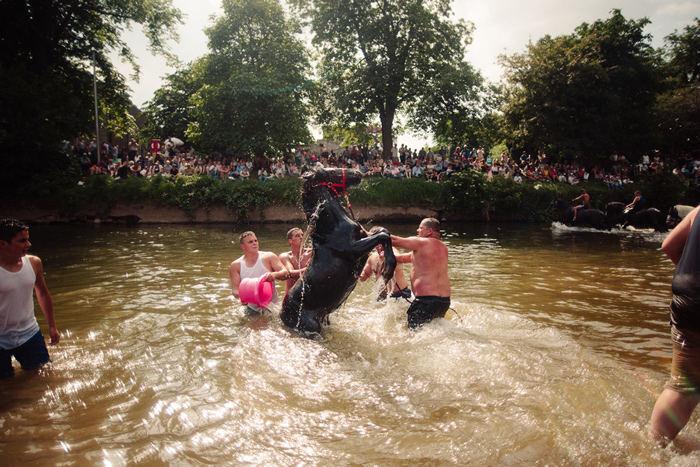 Horses are washed in the Eden River before being paraded through town for the Appleby Horse Fair last June.
Horses are washed in the Eden River before being paraded through town for the Appleby Horse Fair last June.
The annual fair is Europe's largest gathering of gypsies and travellers. It is also one of the oldest fairs in England, occurring every June since 1685, when King James II granted a royal charter permitting a horse fair "near to the River Eden" in Cumbria; an estimated 10,000 English and Welsh gypsies, Irish travellers, and Scottish gypsy/travellers assemble for the fair to buy and sell horses and catch up with friends and relatives.
In recent years, the gypsies are joined by about 30,000 non-travellers (muggles?) who travel to Appleby to see the gypsies and their horses.
"Appleby Horse Fair is not an organised event," warns a local government publication aimed at potential tourists. "There is no set programme for anything happening. The horses are washed and trotted up and down the flashing lane.
"There is a market on Jimmy Winter's field selling a variety of goods–some traditional to the gypsy/travelling community–and other. To arrange to sell on that field, please contact Jimmy Winter....
"There is no horse auction. Sale arrangements are made buyer to seller for cash. The price will usually include extra for Luck Money."
Tourists are also warned that accommodations in the vicinity during fair week will be "rarer than hen's teeth. If you have a tent, however, you may be able to camp at Holme Farm Field. Speak to Mrs. Bousfield."
landscape
animals
England
horses
festival
Eden River
Cumbria
Appleby
(Image credit: Kristian Helgesen)
Mar 9, 2016
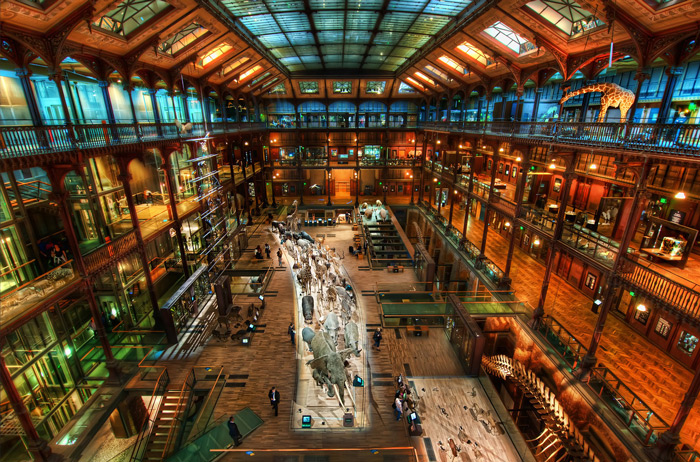 Also taxidermiferous! Displaying life that is no longer with us, at the Muséum national d'Histoire Naturelle in Paris.
Also taxidermiferous! Displaying life that is no longer with us, at the Muséum national d'Histoire Naturelle in Paris.
museum
animals
architecture
Paris
taxidermy
fossils
(Image credit: Trey Ratcliff via Stuck in Customs)
Jun 8, 2016
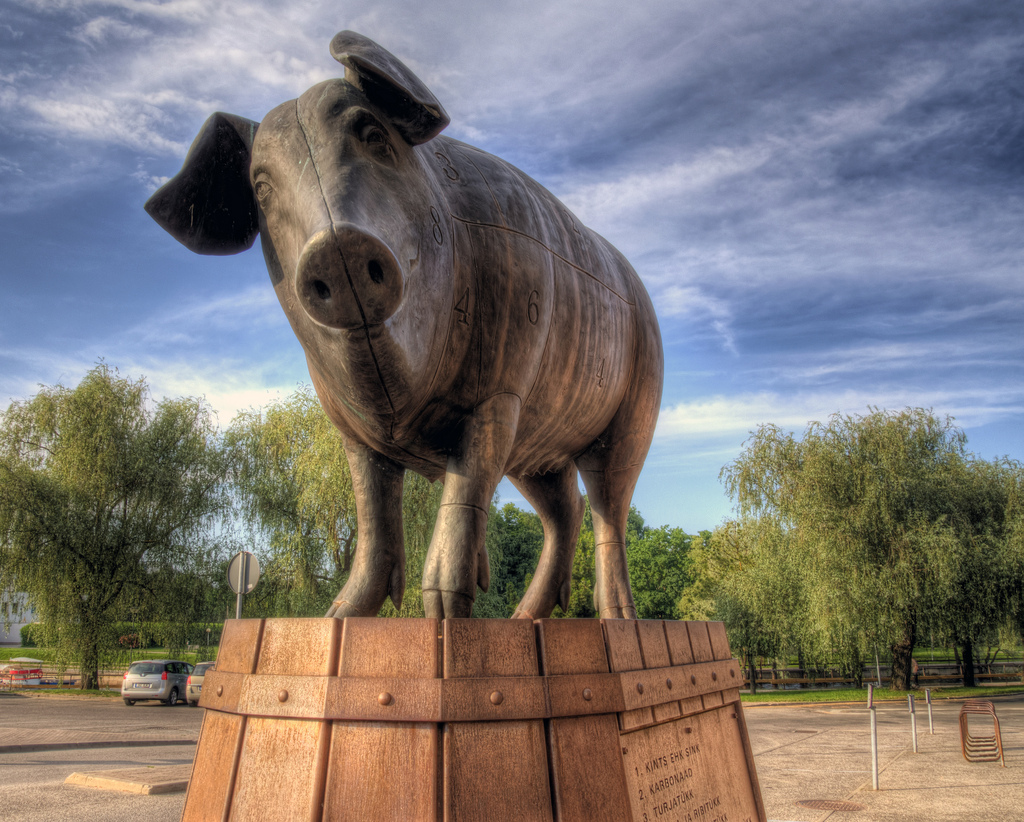 They go to market, of course. Above, in Tartu, Estonia; below, here in Philly at Reading Terminal Market.
They go to market, of course. Above, in Tartu, Estonia; below, here in Philly at Reading Terminal Market.
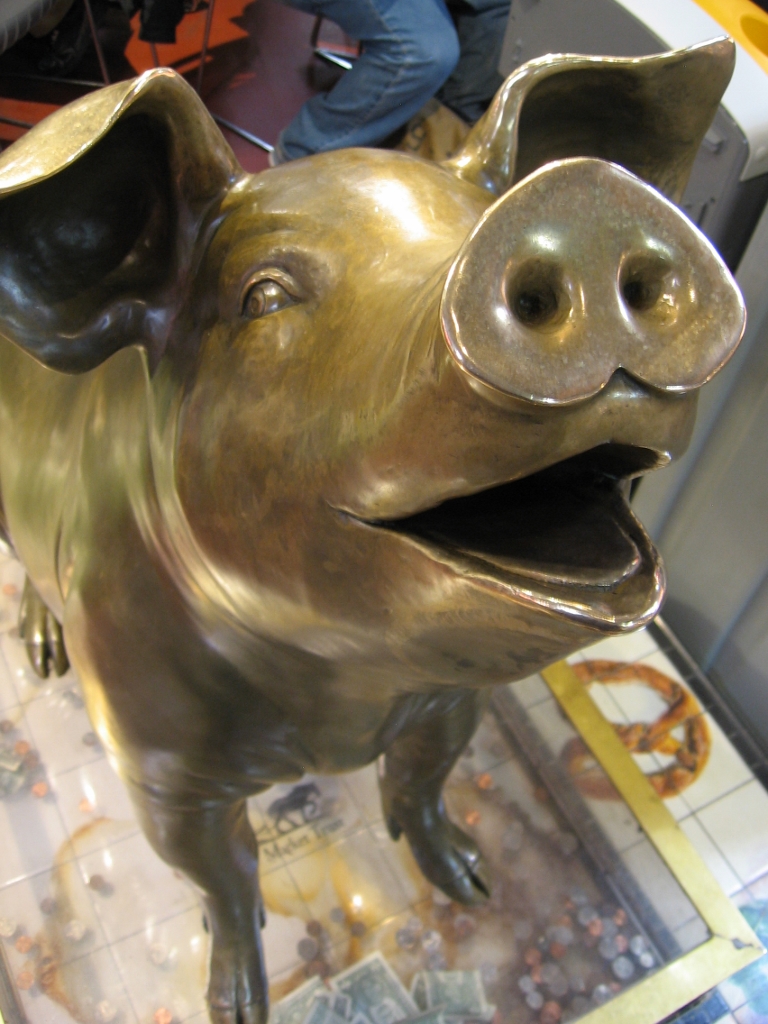
Estonia
animals
sculpture
Philadelphia
pigs
bronze
public art
Tartu
Reading Terminal Market























 Fifteenth-century pilgrims to the Middle East, upon returning to Europe in 1486, published an account of their journey. "These animals were faithfully painted just as we saw them in the Holy Land," they reported. "Giraffe. Crocodile. Indian goat. Unicorn. Camel. Salamander. The name of this one is not known."
Fifteenth-century pilgrims to the Middle East, upon returning to Europe in 1486, published an account of their journey. "These animals were faithfully painted just as we saw them in the Holy Land," they reported. "Giraffe. Crocodile. Indian goat. Unicorn. Camel. Salamander. The name of this one is not known."






 In hopes of fostering the development of medical science in Russia, Peter the Great scoured the West for natural history objects: taxidermy, live birds and insects, botanical and anatomical illustrations, and paraphernalia associated with monsters. Albertus Seba, a wealthy Dutch pharmacist and traveler, had amassed the largest natural history collection of the mid-18th century. Peter bought all of Seba's objects and library, including this book of colored zoological plates, and installed everything in St. Petersburg, where it became the nucleus of the Russian national collections.
In hopes of fostering the development of medical science in Russia, Peter the Great scoured the West for natural history objects: taxidermy, live birds and insects, botanical and anatomical illustrations, and paraphernalia associated with monsters. Albertus Seba, a wealthy Dutch pharmacist and traveler, had amassed the largest natural history collection of the mid-18th century. Peter bought all of Seba's objects and library, including this book of colored zoological plates, and installed everything in St. Petersburg, where it became the nucleus of the Russian national collections.
 Above, a newborn panda shortly after its birth last week at a breeding center in Chengdu, Sichuan province, China. Below, a few-days-old baby panda in Chengdu works out.
Above, a newborn panda shortly after its birth last week at a breeding center in Chengdu, Sichuan province, China. Below, a few-days-old baby panda in Chengdu works out.








 The 2013 photographer of the year for the GDT. a society of German wildlife photographers, is eighteen-year-old Hermann Hirsch, who called his winning shot "Evening Idyll."
The 2013 photographer of the year for the GDT. a society of German wildlife photographers, is eighteen-year-old Hermann Hirsch, who called his winning shot "Evening Idyll."



